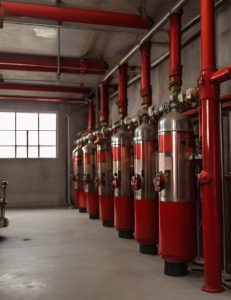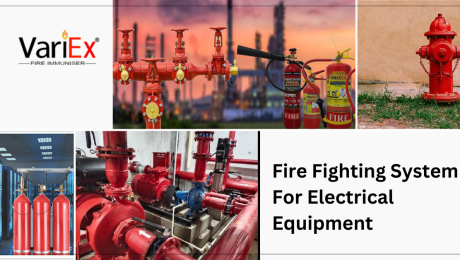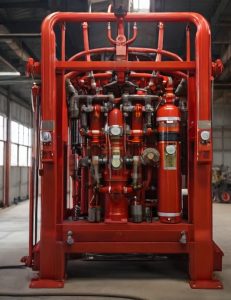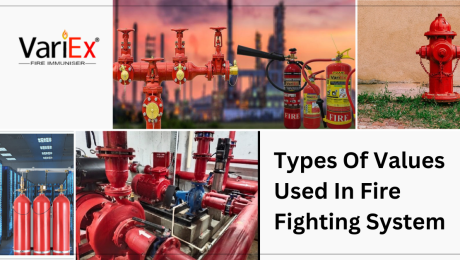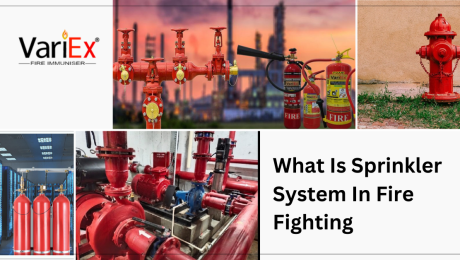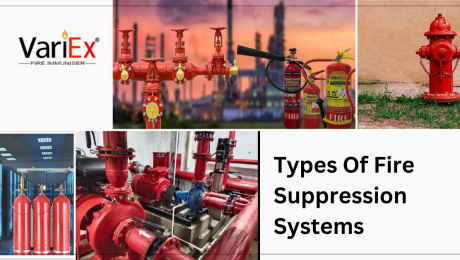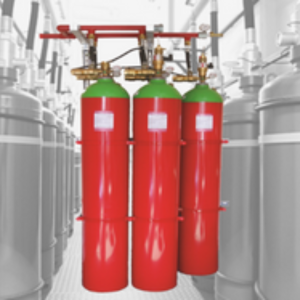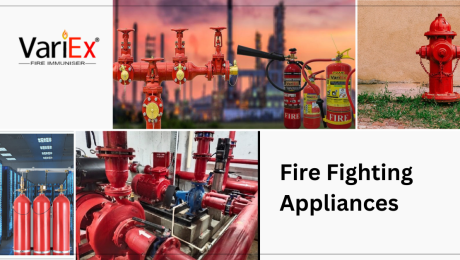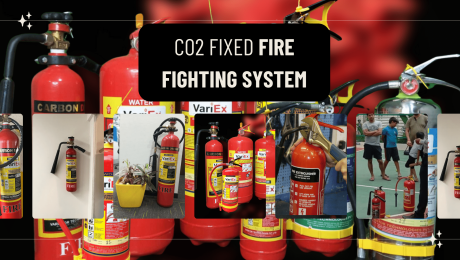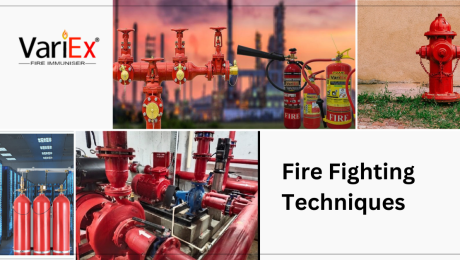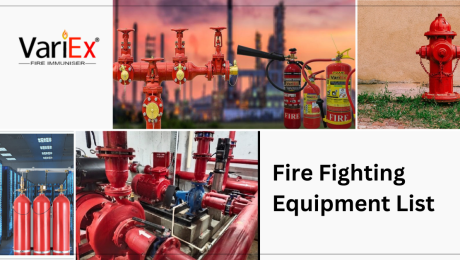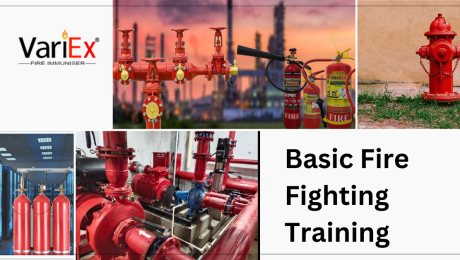A fire fighting system is a crucial component of any building’s safety infrastructure, designed to detect, control, and extinguish fires effectively. These systems typically include various elements such as fire alarms, sprinklers, fire extinguishers, and smoke detectors.
Automatic fire sprinkler systems are among the most common fire fighting systems, capable of quickly detecting heat and releasing water to suppress flames. Fire alarms play a vital role in alerting occupants to the presence of fire, allowing for prompt evacuation.
Additionally, portable fire extinguishers provide a means for immediate response to small fires, helping to contain them before they escalate. Smoke detectors detect the presence of smoke, triggering alarms and activating ventilation systems to aid in smoke removal.
Regular maintenance and testing of fire fighting systems are essential to ensure their reliability during emergencies. Properly functioning fire fighting systems can significantly mitigate the risk of property damage and save lives in the event of a fire.
Fire Fighting System Installation Procedure
Tuesday, 27 February 2024 by Sonu Shree
Installing fire fighting systems is crucial for safeguarding lives and property. This guide outlines the step-by-step procedure for the installation of fire suppression systems to ensure effective protection against fires.
1. Preliminary Assessment:
- Conduct a thorough assessment of the property to identify potential fire hazards and determine the most suitable type of fire fighting system required.
- Consider factors such as building layout, occupancy type, and regulatory requirements.
2. Design and Planning:
- Engage with certified fire protection engineers to develop a customized fire fighting system design based on the assessment findings.
- Determine the placement of fire suppression equipment, such as sprinklers, detectors, alarms, and extinguishers, to ensure comprehensive coverage.
3. Permitting and Regulatory Compliance:
- Obtain necessary permits and approvals from local authorities before commencing installation.
- Ensure compliance with relevant building codes, fire safety standards, and regulations.
- Published in Fire Fighting System
No Comments
Fire Fighting System For Electrical Equipment
Tuesday, 27 February 2024 by Sonu Shree
In today’s technologically driven world, the reliance on electrical equipment is ubiquitous, spanning industries from manufacturing plants to data centers and commercial buildings. However, alongside the convenience and efficiency these systems provide, there exists a persistent risk of electrical fires. These fires, often swift and devastating, pose significant threats to personnel safety, property integrity, and business continuity. To address this critical issue, the implementation of comprehensive fire fighting systems specifically tailored for electrical hazards is paramount.
Business fire safetyfire alarmfire alarm systemFire Alarm System for homefire extinguisherFire Extinguishersfire extinguishers in bengaluruFire FightingFire Fighting Equipment Supplierfire fighting sprinkler systemfire fighting sprinklers systemFire fighting systemfire fighting system in bengaluruFire fighting system worksFire SafetyFire Safety at HomeFire Safety at hospitalFire Safety at Workplacefire safety awarenessfire safety brandFire safety during covidfire safety equipmentfire safety equipment for schoolFire safety equipmentsfixed fire fighting system
Air Release Value In Fire Fighting System
Thursday, 22 February 2024 by Sonu Shree
In the realm of fire safety, every component of a fire fighting system plays a crucial role in ensuring effective operation. Among these components, air release valves hold particular importance, facilitating the efficient performance of fire suppression systems. This article delves into the significance of air release valves in fire fighting systems, exploring their functionality, benefits, and key considerations.
Understanding Air Release Valves: Air release valves are integral components of fire fighting systems, designed to automatically release trapped air from pipelines. Trapped air can hinder the flow of water within the system, compromising its ability to suppress fires effectively. Air release valves prevent the accumulation of air pockets by allowing trapped air to escape, ensuring uninterrupted water flow and optimal system performance.
- Published in Fire Fighting System
Types Of Valves Used In Fire Fighting System
Thursday, 22 February 2024 by Sonu Shree
In the realm of fire safety, the effectiveness of fire fighting systems relies heavily on the proper functioning of various valves. These valves play a critical role in controlling the flow of water, directing it to the areas where it’s needed most during fire suppression efforts. This article delves into the different types of valves used in fire fighting systems, highlighting their functions and importance in ensuring swift and effective response to fires.
abc fire extinguisherfire alarmfire alarm systemFire Alarm System for homefire extinguisherFire ExtinguishersFire Extinguishers GasFire FightingFire fighting systemfire fighting system in bengaluruFire SafetyFire Safety at HomeFire Safety at hospitalFire Safety at Workplacefire safety awarenessfire safety brandfire safety equipmentFire safety equipmentsFire suppression
What Is Sprinkler System In Fire Fighting
Thursday, 22 February 2024 by Sonu Shree
In the realm of fire safety, sprinkler systems stand as a cornerstone of defense against the devastating effects of fires. These systems play a crucial role in swiftly detecting, containing, and extinguishing fires, thereby safeguarding lives and property. This article delves into the intricacies of sprinkler systems in fire fighting, exploring their components, functionality, and importance.
- Published in Fire Fighting System
Types Of Fire Suppression Systems
Thursday, 22 February 2024 by Sonu Shree
Fire suppression systems play a critical role in safeguarding lives and property by swiftly controlling or extinguishing fires. With diverse environments and fire hazards, various types of fire suppression systems have been developed to address specific needs. This comprehensive guide delves deeper into the different types of fire suppression systems and their applications.
Water-Based Fire Suppression Systems:
- Wet Pipe Sprinkler Systems: Utilizing water as the extinguishing agent, wet pipe sprinkler systems feature pipes filled with pressurized water connected to sprinkler heads. These heads are activated by heat, releasing water directly onto the fire. Commonly found in residential, commercial, and industrial settings, wet pipe systems are reliable and effective for a wide range of fire hazards.
- Deluge Systems: Deluge systems are designed for high-hazard environments where rapid fire spread is a concern. Unlike traditional sprinkler systems, deluge systems employ open sprinkler heads that discharge water simultaneously upon detection of fire or manual activation. They are commonly used in facilities with highly flammable materials, such as chemical plants and power stations.
- Pre-action Systems: Pre-action systems incorporate elements of both wet and dry pipe systems. Water is held back by a valve until a fire detection system signals the need for suppression. Once activated, water flows into the pipes and is discharged through sprinklers. Pre-action systems are ideal for areas where accidental water discharge could cause significant damage, such as data centers, museums, and libraries.
- Published in Fire Fighting System
Basic Fire Fighting Training
Thursday, 22 February 2024 by Sonu Shree
- Published in Fire Fighting System
Fire Fighting Pump Room Details
Thursday, 22 February 2024 by Sonu Shree
A fire fighting pump room is a critical component of any fire protection system, responsible for ensuring adequate water supply to fight fires effectively. In this brief guide, we will delve into the essential details of fire fighting pump rooms, including their design, components, and importance in safeguarding lives and property.
1. Design of Fire Fighting Pump Rooms:
- Fire fighting pump rooms are typically designed to house various components necessary for water distribution during fire emergencies. The design considerations include factors such as space requirements, accessibility, and proximity to water sources.
2. Components of Fire Fighting Pump Rooms:
- Fire fighting pump rooms contain several key components, including:
- Fire pumps: These pumps are responsible for drawing water from a water source, such as a tank or municipal supply, and distributing it to fire suppression systems.
- Controllers: Control panels or devices monitor and regulate the operation of fire pumps, ensuring they activate automatically during fire emergencies.
- Valves: Valves control the flow of water within the pump room and throughout the fire protection system, allowing for isolation of sections or zones as needed.
- Pipes and fittings: Pipes and fittings distribute water from the fire pumps to sprinkler systems, hydrants, standpipes, and other fire suppression equipment.
- Published in Fire Fighting System
Fire Fighting Appliances
Thursday, 22 February 2024 by Sonu Shree
- Published in Fire Fighting System
Co2 Fixed Fire Fighting System
Thursday, 22 February 2024 by Sonu Shree
CO2 fixed fire fighting systems are vital components of fire protection strategies in various industries and facilities. These systems utilize carbon dioxide (CO2) to suppress fires quickly and effectively, making them suitable for use in environments where water-based suppression methods may be impractical or hazardous. In this article, we’ll delve into the details of CO2 fixed fire fighting systems, including their components, operation, benefits, and considerations for implementation.
- Published in Fire Fighting System
Fire Fighting Techniques
Thursday, 22 February 2024 by Sonu Shree
- Published in Fire Fighting System
Fire Fighting Equipment List
Thursday, 22 February 2024 by Sonu Shree
- Published in Fire Fighting System
Basic Fire Fighting Training
Monday, 19 February 2024 by Sonu Shree
- Published in Fire Fighting System
History Of Fire Fighting And Prevention
Monday, 19 February 2024 by Sonu Shree
Fire has been both a friend and foe to humanity throughout history. While it has provided warmth, light, and the ability to cook food, it has also posed significant risks to life and property. The history of fire fighting and prevention is a testament to humanity’s ingenuity and resilience in the face of this formidable adversary. In this article, we’ll journey through time to explore the evolution of fire fighting and prevention techniques, from ancient civilizations to modern innovations.
- Published in Fire Fighting System
Types Of Fire Suppression Systems
Monday, 19 February 2024 by Sonu Shree
- Published in Fire Fighting System



